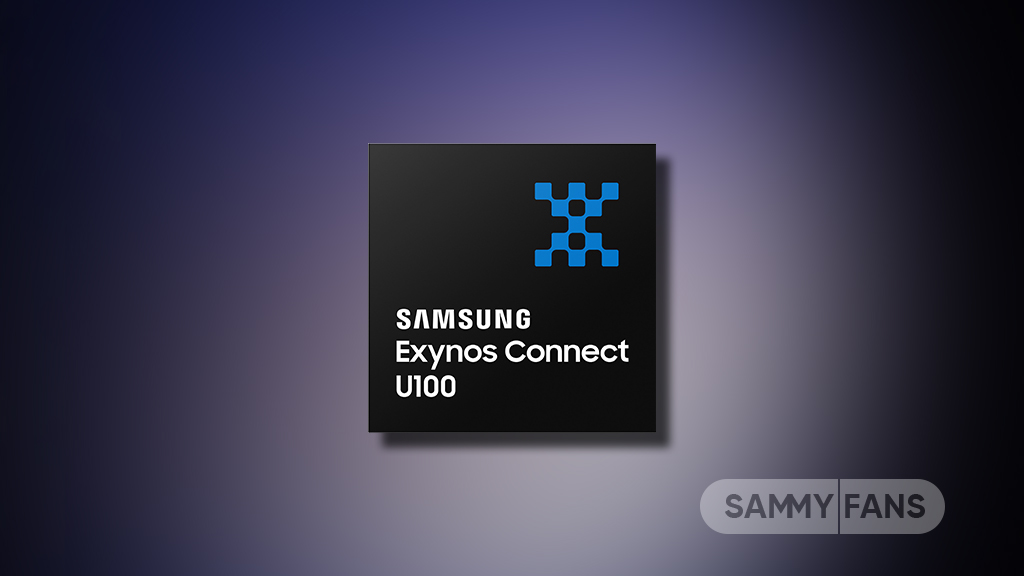News
Samsung launches Exynos Connect U100, new mobile-optimized UWB solution

Samsung introduced the first UWB (Ultra Wideband) based short-range wireless communication chipset – Exynos Connect U100. With this product, the company also unveiled the Exynos Connect brand.
The Exynos Connect brand includes semiconductors based on UWB, Bluetooth, and Wi-Fi, and strengthens its competitiveness in the wireless communications semiconductor business in preparation for the advent of a hyper-connected society.
Samsung Exynos Connect U100 chip executes a power mode optimized for each operation and is suitable for IoT devices such as mobile devices, electric vehicles, and tags that require long-term operation with low-capacity batteries.

UWB is a short-range wireless communication technology that can transmit large amounts of information quickly with low power over a wide frequency band. It can accurately measure the distance and position between devices within a few centimeters, making it suitable for various fields such as smart keys, smart homes, and smart factories. It is the center of attention.
Samsung Exynos Connnect U100
Samsung Exynos Connect U100 combines RF (radio frequency), eFlash (embedded flash memory) memory, and power management IP (intellectual property) into a single chip, so it can be easily implemented on small devices.
It is equipped with STS (Scrambled Time Stamp Sequence) function to prevent external hacking during communication and is equipped with a secure hardware encryption engine, so it has excellent security performance.

Furthermore, by implementing the Time of Arrival (ToA) and Angle of Arrival (AoA) functions, accurate distance/position measurement and direction detection is possible even in complex environments.
In this way, even when GPS is difficult to use, accurate positioning can be performed within a few centimeters and within a range of less than 5°, enabling position tracking, and virtual reality (VR) or can be applied to augmented reality measurements.
Moreover, it supports the Digital Key Release 3.0 standard of Car Connectivity Consortium which stores the vehicle’s digital key value and shares user authentication.
According to Joonsuk Kim, Executive Vice President of the Connectivity Development Team at Samsung Electronics:
“Our Exynos Connect U100 combines sophisticated ranging and positioning capabilities with strong security to enable hyper-connectivity between people and everyday objects, fueling a range of new applications in positioning and location tracking. Building on our technology leadership in communications technologies, we are committed to driving innovation in short-range communication solutions to transform the way we connect and relate to the world around us.”
News
Samsung brings huge energy-saving opportunity to New York

New York became the first US state to bring retail consumer rebates for appliances under the Inflation Reduction Act. Applauding the move, Samsung launched a huge energy-saving opportunity for the residents of New York.
Samsung started offering up-front discounts to consumers statewide through New York’s IRA HEAR program. Consumers can now access IRA’s Home Electrification and Appliance Rebate (HEAR) program.
IRA HEAR rebate program advantages
- Save up to $840 on Samsung’s innovative ENERGY STAR products, including laundry appliances like heat pump dryers and all-in-one combo washers + heat pump dryers.
Visit Samsung’s home appliance page to learn more about the options available.

Samsung said this is just the beginning of its rebates journey in New York. The company looks forward to working with partners to expand these retail rebates to more products and in more states across the United States.
Pay attention, the IRA provides rebates and tax credits to households across America. New York is leading the way in providing direct retail point-of-sale appliance rebates, supporting an affordable clean energy transition.
Inflation Reduction Act
Signed in August 2022, the Inflation Reduction Act is the single largest investment in climate and energy in American history.
It provides home appliance rebates for discounts on electric energy-efficient appliances like Induction cooktops, ranges, and heat pump laundry appliances.
News
Watch: Samsung Galaxy Watch Ultra conquers grueling military training

Samsung Galaxy Watch Ultra has undergone one of the most extreme military tests. The company has recently published a Watch Ultra test video, featuring Phillip Chu Joy.
Phillip participated in the Peruvian Navy’s Special Operations Course to showcase the watch’s capabilities. It is renowned as one of the world’s most challenging military training programs.
“The Galaxy Watch Ultra pushes technology to its limits, handling extreme conditions with ease,” Chu Joy remarked. “It’s undoubtedly designed for those seeking exceptional performance.”
The Samsung Galaxy Watch Ultra proves its durability and functionality in water, mud, and sand — excelling even under the grueling conditions of Peru’s most extreme military training.
Galaxy Watch Ultra
The Watch Ultra boasts a Grade 4 titanium frame. It also features a shockproof cushioned design that meets MIL-STD-810H2 military standards and water resistance of up to 10ATM.

The product is capable of operating within a broad temperature range of -20°C to 55°C4 and performing at altitudes of up to 9,000 meters above sea level.
These capabilities make it ideal for tracking advanced physical activities like ocean swimming and cycling in extreme conditions; take the Perivian military training as a recent proven example.
Samsung’s Watch Ultra is the ultimate companion for sports enthusiasts and extreme adventurers. It’s crafted to endure the toughest conditions with its pro-grade features and premium materials.
Samsung’s Mauricio Revollar stated:
“We wanted the public to experience the Galaxy Watch Ultra like never before in the Peruvian market by creating the most extreme product review ever undertaken here.”
“This was made possible thanks to the collaboration of the Peruvian Navy, which allowed us to highlight and celebrate the commitment of the students in one of the world’s most demanding military training programs.”
Watch the video below:
News
OpenAI eyes AI integration on Samsung phones like Apple Intelligence

Apple collaborated with OpenAI to power Apple Intelligence features. The ChatGPT maker continues to create obstacles for Google. In a recent move, OpenAI discussed a potential AI partnership with Samsung.
TheInformation (via Reuters) reported that OpenAI has recently discussed powering AI features on Samsung-made devices. It seems the ChatGPT-maker wishes an AI partnership with Samsung to expand its reach in multiple folds.
The company is considering developing a web browser to rival Google’s Chrome. OpenAI recently introduced its search engine called SearchGPT. It is available to limited users alongside internal testers and strategic partners.
Samsung x OpenAI
Samsung and Google’s close partnership doesn’t need any elaboration. The friendship isn’t limited to services, as both firms work across an ecosystem. However, it doesn’t stop Samsung from partnering with OpenAI in favor of better service.
As the AI phone market is growing rapidly, OpenAI may innovate further. Google doesn’t lag, but there’s still room for a potential alliance. Apple Intelligence-like features might be deployed on Galaxy phones after Samsung’s partnership.
OpenAI knows Samsung holds the command of the worldwide smartphone market. Expansion of its services will be quite broader than Apple if its partnership with Samsung pens down. For now, take this information as a grain of salt!

Apple x OpenAI
Apple leads the worldwide premium smartphone market. Google and Samsung introduced their AI phones in October 2023 and January 2024, respectively. It forced Apple to immediately enter the segment to normalize the innovation gap.
Google’s availing Gemini Nano AI model, but Apple joined hands with OpenAI. To create a difference, OpenAI powering some of the coolest AI features on recent iPhones. The move is to attract other vendors to adopt source AI from OpenAI.
Well, Apple still reportedly considering bringing Gemini AI on iPhones. The company believes that iPhone users should have different AI providers available. Hence, a multi-collaborative approach is also in the pipeline, at least from Apple’s end.












